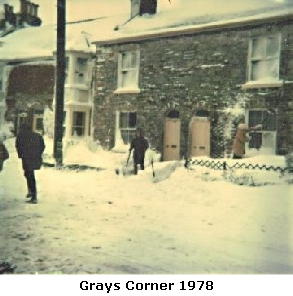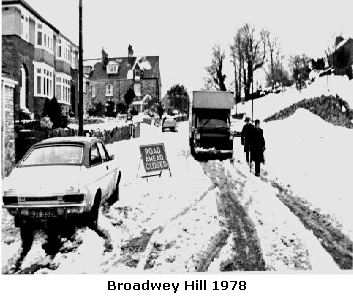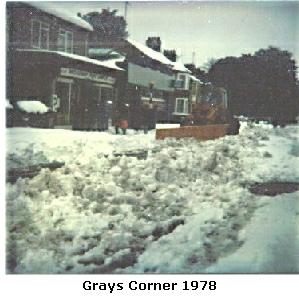

William Stanley
Peter Miles
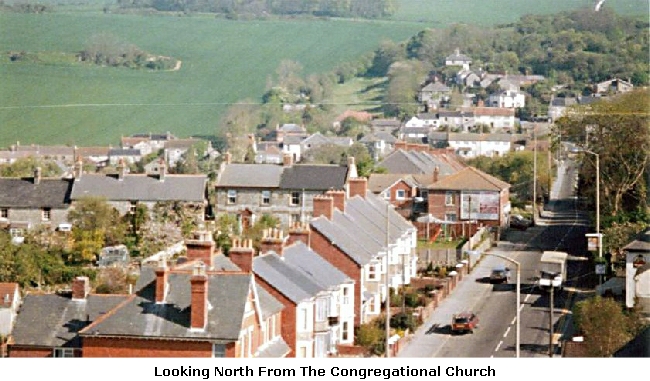
The 1970's was a time of great change in the villag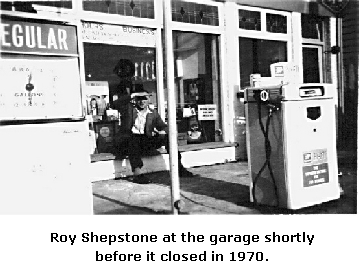 e. The link with Broadwey became stronger than ever as Upwey's shops and school closed. Gray's Corner became the local shopping area for both villages. Upwey children joined Broadwey children at St Nicholas & St Laurence School which was built next to Broadwey Secondary Modern School at Nottington Corner.
e. The link with Broadwey became stronger than ever as Upwey's shops and school closed. Gray's Corner became the local shopping area for both villages. Upwey children joined Broadwey children at St Nicholas & St Laurence School which was built next to Broadwey Secondary Modern School at Nottington Corner.
The redundant Victorian water pumping station at Gould's Bottom was demolished in April 1970. It had not been used since 1914, when the new pumping station or 'waterworks' had been built on Friar Waddon Road. The original worker's cottage was retained and sold.
At the Royal Standard, Ernie Plowman took over the licence from Mrs Grace Fooks in November 1973. Roy Reynolds was at The Masons Arms.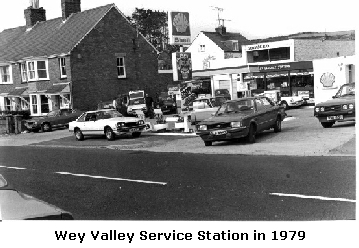
In 1970 Roy Shepstone retired from the garage business on Dorchester Road which his father had started in 1919. The business was sold to local racing driver, Win Percy, who re-
The Congregational Church on the corner of Chapel Lane became the Upwey United Reformed Church and had strong links with the Radipole United Reformed Church. Rev Maliphant and his wife lived at The Manse. As with any old building, a lot of maintenance was required; and the Church very much appreciated Mr Hampton's generosity; particularly in the restoration of the church doors; decoration of the entrance porch and donation of a new gate. Services continued there until 1992 when the church was closed.
The 'bakers' shop carried on trading at 829 Dorchester Rd, under the umbrella of 'Weymouth Bakeries', although baking no longer took place on the premises.
By the end of the 1970's Elwell Street had ceased to be the village shopping centre. The premises used by Jimmy 'the Barber' (no 28) wer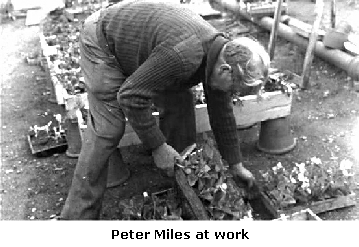 e converted into a private workshop and store in 1973.
e converted into a private workshop and store in 1973.
Following the death of Miss Dunn, aged 80, in 1977, the post office (PO) was closed. There was great concern as the PO served a scattered community between Ridgeway and Goulds Hill. For some people the distance to nearest the PO at Broadwey would be more than 2 miles. During Miss Dunn's illness Mr Lansdown of Elwell St had been temporarily in charge and feared for the safety of elderly people having to walk along and cross a main road to get to PO at Broadwey. The building was sold and converted to a residential property. Mr Eckersall took on the post office duties, around the corner in Church Street. Sadly this was not to be for long as following Mr Eckersall's sudden death in 1979 the grocery shop/post office ceased trading. This was also converted to residential property.
Miss Alice Dunn had been at the post office for 55 years. She trained in post office work at Charminster and in 1922, aged 25, arrived at Upwey to assist Miss Jane Corbin. She took on the role of post mistress after the death of Miss Corbin and for many years was assisted by Miss Wills.
Mr Lovering retired in 1978 and the premises at 40 Elwell St were no longer used as a butchers. The grocery shop at no 34 also closed its doors in the 1970's and became a residential property.
To add to this feeling of loss came the news that Upwey School would close in July 1976. Falling numbers at the school made this inevitable and the 39 Upwey children joined with Broadwey children at the new St Nicholas and St Laurence School in September 1976.
In 1978, following much effort by the Upwey Society, the old school became a community centre with its own management committee. The Upwey Society had been formed in 1974 'to maintain and improve the amenities and natural characteristics of Upwey; and to provide social and informative meetings for the benefit of all villagers'. Also in 1978 Elwell Street was designated a conservation area.
Also at this end of the village planning permission was granted to build a cottage on the site of the Clovelly Tea Gardens.
Further along Church St, next to the mill a new venture started up. A trout farm and hatchery was formed on the site of old watercress beds by Mr Harrison who considered that the site was very good as water rose nearby and was very pure. Rainbow trout were bred, with fish weighing four or five pounds; fry and eggs were supplied to stocking grounds all over the country. The occasional escape of a few small trout into the stream, kept local boys busy fishing!
On the corner of Victoria Avenue permission had been granted to demolish 640 Dorchester Road and build Cassea Court (an amalgamation of the builders' names, Caswell & Seager), comprising of 15 flats in the grounds. This 3-
Shortlands Road and St Lawrence Road were 'adopted' by the council and 'made up'.
At Grays Corner the 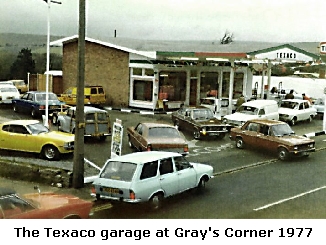 opening of the Texaco garage in 1977, run by Simon Flower caused chaos on the roads. The special price on petrol (£1.30 a gallon of 4 star) led to the road becoming blocked with queuing cars -
opening of the Texaco garage in 1977, run by Simon Flower caused chaos on the roads. The special price on petrol (£1.30 a gallon of 4 star) led to the road becoming blocked with queuing cars -
Many cottages were brought up to date, perhaps having central heating or a fitted kitchen installed and being generally improved. It's rather ironic to think that then it was a trend to replace latched, tongue and grooved doors with flat, hardboard doors and the stone sink with a stainless steel sink/drainer unit -
The 1970's were a time of industrial disputes, particularly with the miners whose strikes resulted in power cuts. These were planned so you knew when they would happen and could prepare with torches or candles and make sure that you'd cooked tea -
White bands were painted around lampposts and signs to help people see them in the dark. At first it was a great novelty to go out in dark -
At the Congregational Church, in March 1972, the scheduled power cut came on Sunday evening at 6pm -
Madge Moon was still running the Youth Club and was proud to receive affiliation to the Dorset Association of Youth Clubs in April 1970. Concerts were planned and performed both at the Memorial Hall and other venues including Weymouth Pavilion.
Until now the villages of Upwey and Broadwey had boasted two cricket teams -
Then in 1976 the U&B Social Club Cricket Team disbanded. They also played at Redlands and had been formed in 1958 by Fred Virgin as part of the social activities of the U&B Memorial Hall.
The 'Clipping of the Church' continued at Upwey Church on Mothering Sunday, this included the blessing of posies brought by children for their mothers and the congregation linking arms around the church in an embrace.
In March 1970 Charlie, (the stone bust of a man in a bowler hat), was returned to his rightful place in the garden of The Masons A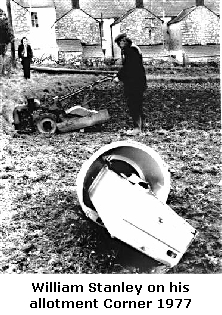 rms. He had been missing since the previous November and was found in a flat in London wearing sunglasses and smoking a pipe!
rms. He had been missing since the previous November and was found in a flat in London wearing sunglasses and smoking a pipe!
William Stanley had a very lucky escape in March 1971 when parts of a Canberra Jet flying overhead, fell on to his market garden off Prospect Place, narrowly missing him as he rotovated his land. Another piece fell into the driveway of William Langridge, just a few minutes after he and his wife had left home. The Jet was flying from RAF Cottesmore in Rutland to RNAS Yeovilton.
In 1975 Dutch elm disease killed 6.5 million trees in the UK. Upwey did not escape and the trees to the south of properties on Stottingway Street, which had formed a windbreak from the south-
The summer of 1976 was one of the hottest known, mothers and children regularly met at the entrance to Westbrook Farm, where the youngsters could play in the shallow water of the ford and mothers and babies sit in the shade of the chestnut trees.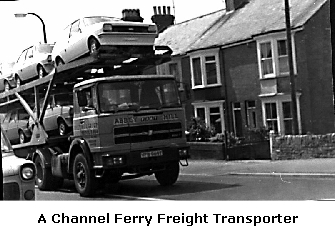
In contrast to this there were often heavy snowfalls in the winter, in 1978 the school was closed for three days due to snow
The traffic on the Dorchester Road was increasing, for a time in the late 1970's, cars were imported via cross-
Villagers in Upwey and Broadwey joined together to mark the Queen's Silver Jubilee in June 1977.
The Silver Jubilee Celebrations Committee  was formed from members of the organisations in the parishes to organise events. An information sheet was delivered to every house in both parishes. Brian Marsh was Chairman and Andy Miller, Secretary.
was formed from members of the organisations in the parishes to organise events. An information sheet was delivered to every house in both parishes. Brian Marsh was Chairman and Andy Miller, Secretary.
All the children in the parishes under the age of 15 received a Jubilee Crown in a presentation case. Their names were recorded in a book.
30 April -
6 June -
6 June -
7 June -
16 June -
The school held a tea party in the school field on Wednesday 1 June. Children, teachers and helpers all wore patriotic colours; the tables were gaily decorated and the whole array presented a most colourful and memorable sight. After tea and the singing of the Jubilee hymn, the classes assembled in their rooms where each child was presented with a souvenir mug provided by PTA funds. A commemorative willow tree presented by a parent was planted in front of the school.
Upwey Society planted trees to celebrate Jubilee.
As a joint celebration of the Queen's Silver Jubilee and the Diamond Jubilee of the Dorset Federation of WI's a buffet supper and old-

Village Life in the 1970's
